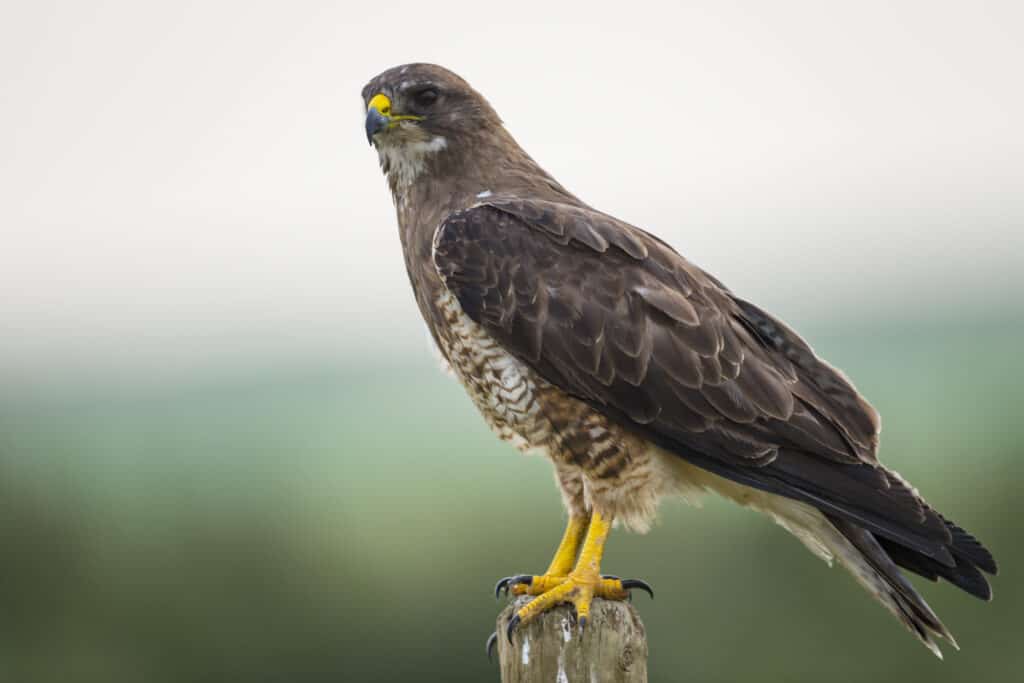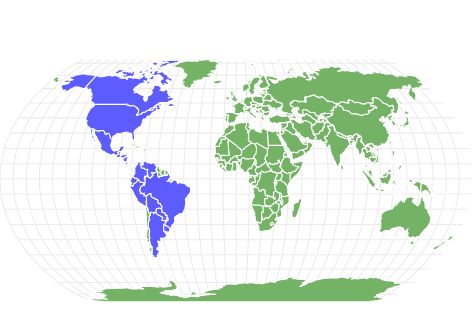Swainson’s Hawk
Buteo swainsoni
Their wings form a “V” shape when flying.
Advertisement
Swainson’s Hawk Scientific Classification
- Kingdom
- Animalia
- Phylum
- Chordata
- Class
- Aves
- Order
- Accipitriformes
- Family
- Accipitridae
- Genus
- Buteo
- Scientific Name
- Buteo swainsoni
Read our Complete Guide to Classification of Animals.
Swainson’s Hawk Conservation Status
Swainson’s Hawk Facts
- Prey
- small mammals, reptiles, and large insects
- Name Of Young
- Nestlings, fledglings
- Group Behavior
- Social
- Fun Fact
- Their wings form a “V” shape when flying.
- Estimated Population Size
- Unknown
- Biggest Threat
- loss of foraging and breeding grounds due to urbanization
- Most Distinctive Feature
- White wing linings
- Distinctive Feature
- slim bodies, long wings
- Wingspan
- 46 to 54 inches
- Incubation Period
- 34 to 35 days
- Age Of Fledgling
- 42 to 44 days
- Habitat
- grasslands, savannas, plains
- Predators
- great horned owls, coyotes, golden eagles, and bobcats
- Diet
- Carnivore
- Lifestyle
- Diurnal
- Type
- Bird
- Common Name
- Swainson's hawk
- Special Features
- Hooked bill
- Number Of Species
- 1
- Location
- North America, South America
- Nesting Location
- Prairie regions with scattered trees
- Migratory
- 1
View all of the Swainson’s Hawk images!
“Swainson’s hawks are long-distance migrants, and almost the entire population moves from North America to South America during August and September.”
Summary
The Swainson’s hawk (Buteo swainsoni) is a medium-sized raptor native to North and South America. They live in open areas with scattered thickets of trees, like grasslands and prairies. They spend their days soaring low to the ground or perched on fence posts and utility poles, searching for prey. These long-distance migrants make an arduous journey from Canada and the Northern United States to Argentina each year. Learn everything there is to know about this bird of prey, including where they live, what they eat, and how they behave.
5 Amazing Swainson’s Hawk Facts
- Their annual migration is over seven thousand miles, taking around two months to reach their destination.
- Swainson’s hawks are social birds, forming monogamous pair bonds and joining small groups or soaring in flocks.
- Their wings form a “V” shape when flying.
- While they often soar low to the ground to catch prey, they may also run on the ground to catch insects.
- Pairs are highly aggressive when defending their nests and usually run off any intruders.
Where to Find the Swainson’s Hawk
Swainson’s hawks live in North and South America in 19 countries, including Canada, the United States, Mexico, Costa Rica, and Argentina. They are long-distance migrants who move from North America to South America during late summer. They inhabit open areas like grasslands, savannas, plains, farmlands, and cultivated lands. This bird only requires a small thicket of trees for nesting. Look for them soaring in flocks, perched on posts, or scattered on the ground, looking for food.
Swainson’s Hawk Nest
They nest in prairie regions with scattered trees, where they typically place their nests well-hidden by vegetation. Occasionally, they nest on old magpie nests, cliffs, ledges, steep slopes, or tall shrubs. They construct a platform of sticks and leafy green branches and line the inside with weeds.
Scientific Name
The Swainson’s hawk (Buteo swainsoni) is from the Accipitriformes order in the Accipitridae family, encompassing small to large birds with strongly hooked bills. The Buteo genus includes wide-ranging raptors called “buzzards” or “hawks.” This species is monotypic, meaning there are no subspecies of the Swainson’s hawk.
Size, Appearance, & Behavior

©BGSmith/Shutterstock.com
The Swainson’s hawk is a medium-sized raptor, measuring 17 to 22 inches long and weighing 1.1 to 3.7 pounds, with a 46 to 54-inch wingspan. They have slim bodies and long wings, which they hold in a “V” shape when soaring. They also have a hooked bill and a fan-shaped tail. And they have light undersides with reddish-brown breasts and brown or gray upper parts. Their flight feathers are black, and they have distinctive white wing linings. Males have gray heads, and females have brown heads. Some species are darker and can be reddish to almost all black.
These birds are social, forming monogamous pair bonds and joining small groups outside the breeding season. You will often find them soaring in flocks or perched on fence posts and utility poles. Occasionally, they sit scattered on the ground. These hawks are not overly noisy but give a hoarse scream (“kreeee”) when perched or in flight. They soar on rising air currents with their tails and wings spread wide.
Migration Pattern and Timing
Swainson’s hawks are long-distance migrants, and almost the entire population moves from North America to South America during August and September. They breed in the western half of the United States and Canada and migrate through Mexico, Central America, and Northern South America before reaching their wintering grounds in Argentina, Uruguay, and Southern Brazil. They travel a total of 12,000 miles during their journey.
Diet
Swainson’s hawks are carnivores who hunt by soaring low over grasslands.
What Does the Swainson’s Hawk Eat?
Their diet consists of small mammals, reptiles, and large insects. They feed their young squirrels, gophers, small birds, mice, snakes, and lizards. They occasionally eat bats and carrion. In late summer, they rely heavily on grasshoppers and caterpillars. They hunt by perching and scanning the ground or soaring low over grasslands. They can also run on the ground, searching for insects.
Predators, Threats, and Conservation Status
The IUCN lists the Swainson’s hawk as LC or “least concern.” Due to its extensive range and large, stable population, this species does not meet the “threatened” status thresholds. The biggest threat to this hawk is their loss of foraging and breeding grounds due to urbanization. They may also be susceptible to the future effects of climate change, such as spring heat waves and wildfires.
What Eats the Swainson’s Hawk?
Swainson’s hawks have very few natural predators, but their nests can become vulnerable to certain species, such as great horned owls, coyotes, golden eagles, and bobcats. These hawks are highly aggressive when defending their nests and typically have no problems driving off intruders and potential predators.
Reproduction, Young, and Molting
These hawks are monogamous and form long-term pair bonds, and their courtship involves aerial displays. Females lay two to three dull white eggs and incubate them for 34 to 35 days, while they may bring food. Both parents assist in feeding their chicks, and young fledge the nest 42 to 44 days after hatching but may remain with their parents until the fall migration. This species reaches sexual maturity around two years and has an average lifespan of 10 years, but it can live over 24 years.
Population
The global Swainson’s hawk population is unknown, but they’ve had stable population trends in North America for the last 40 years. They are not experiencing any extreme fluctuations or fragmentations in their numbers.
Related Animals:
Sources:
- https://www.iucnredlist.org/species/22695903/93533217
- https://academic.oup.com/auk/article/94/1/65/5208952
- http://www.prbo.org/calpif/htmldocs/species/riparian/swainsons_hawk.htm
Swainson’s Hawk FAQs (Frequently Asked Questions)
Where do Swainson's hawks live?
Swainson’s hawks live in North and South America in 19 countries, including Canada, the United States, Mexico, Costa Rica, and Argentina.
Are Swainson's hawks rare?
While their population is stable in North America, these hawks are still a rare sight to see. Look for them in grasslands, soaring in flocks or perched on a post.
Do Swainson's hawks eat birds?
Their diet primarily consists of small mammals, reptiles, and large insects. But they also eat small birds, squirrels, gophers, snakes, and lizards.
How can you tell if it's a Swainson's hawk?
They have light undersides with reddish-brown breasts and brown or gray upper parts. Their flight feathers are black, and they have distinctive white wing linings.
What eats a Swainson's hawk?
Swainson’s hawks have very few natural predators, but their nests can become vulnerable to certain species, such as great horned owls, coyotes, golden eagles, and bobcats.
What threatens the Swainson's hawk?
The biggest threat to this hawk is their loss of foraging and breeding grounds due to urbanization. They may also be susceptible to the future effects of climate change, such as spring heat waves and wildfires.
How big is a Swainson's hawk?
The Swainson’s hawk is a medium-sized raptor, measuring 17 to 22 inches long and weighing 1.1 to 3.7 pounds, with a 46 to 54-inch wingspan.
Thank you for reading! Have some feedback for us? Contact the AZ Animals editorial team.
Sources
- California Partners in Flight Riparian Bird Conservation Plan / Brian Woodbridge, Available here: http://www.prbo.org/calpif/htmldocs/species/riparian/swainsons_hawk.htm
- Oxford Academic / The Auk / Sidney W. Dunked, Available here: https://academic.oup.com/auk/article/94/1/65/5208952
- Red List / Bird Life International, Available here: https://www.iucnredlist.org/species/22695903/93533217

















